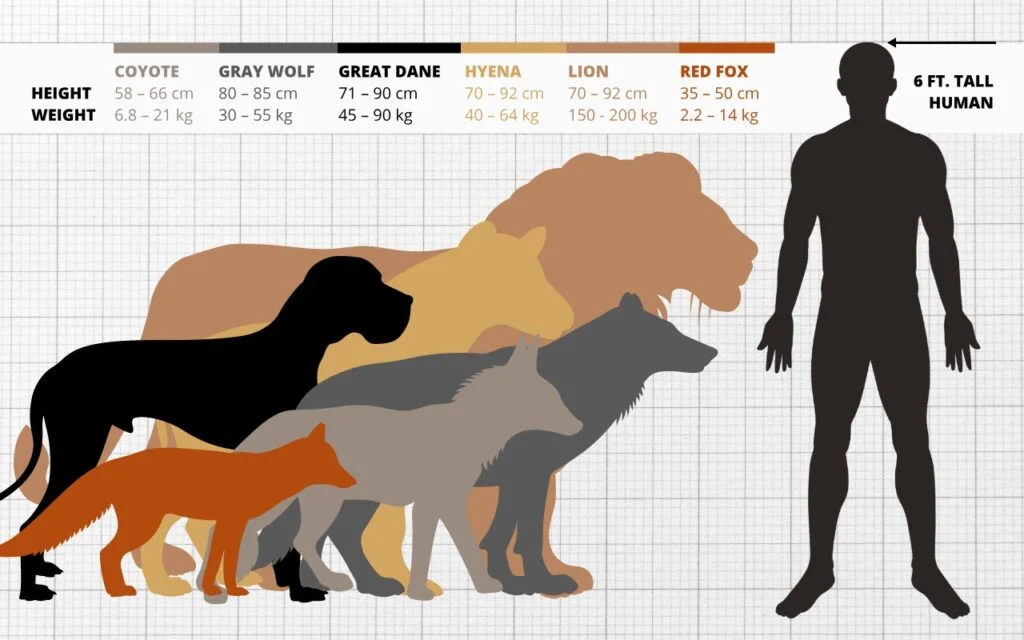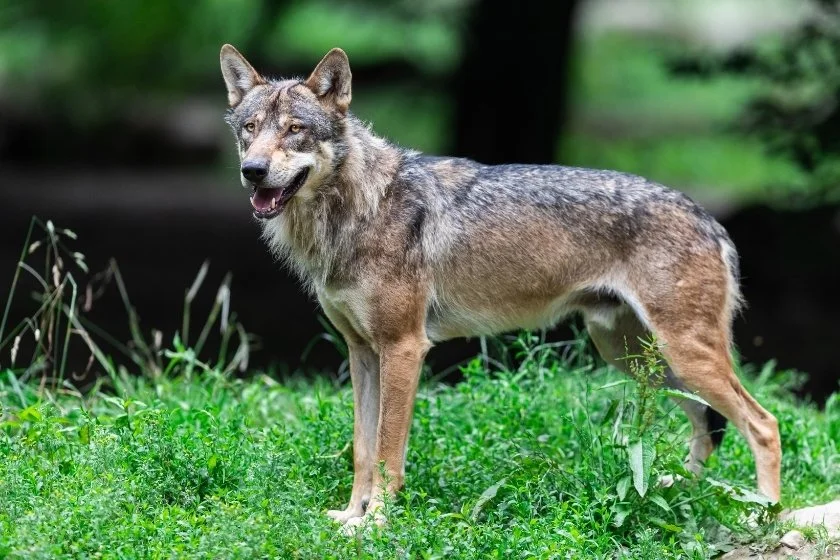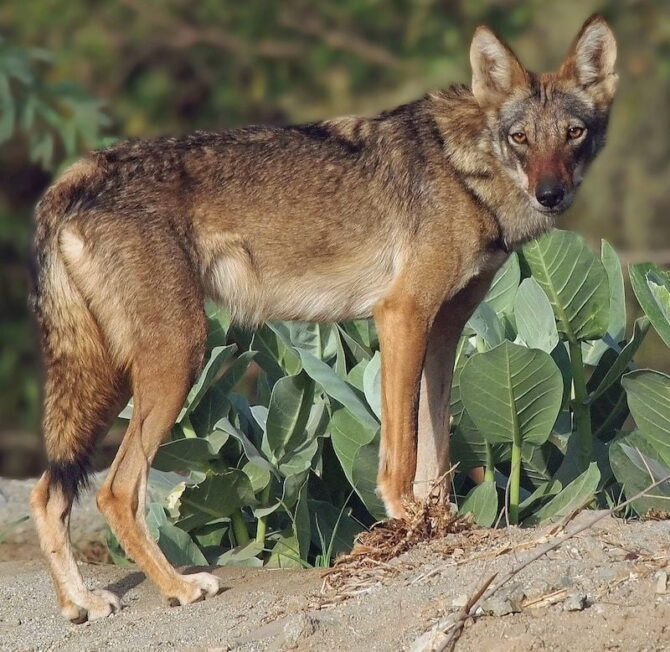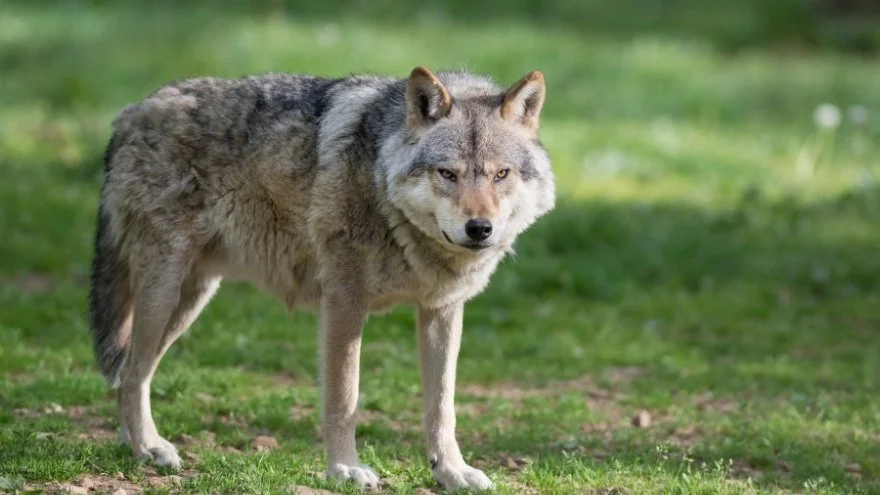The Canis lupus (Wolves) are the largest members of the dog family. Their sizes are determined by species, age, and other conditions.
The gray wolf—which is the largest species—averagely measures about 30 inches, weighs 80–100 pounds, and can grow as large as 175 pounds.
Discoveries about wolves are made yearly as a result of research carried out by experts.
However, myths continue to spread due to some cultures and movie producers’ wrong portrayal of these top predators.
Information about the nature, behavior, and size of wolves is often misconstrued. The size is our focus in this detailed article on wolf size comparison.
On average, humans (170–180 cm) are bigger than wolves (105–160 cm). Members of the big cat family, like lions, tigers, and leopards, are bigger than wolves, but wolves are bigger than dogs.
Read on for more information on how big wolves are and how they compare to other land animals.
How Big Are Wolves?

Wolves are the largest members of the dog family. Generally, adult male wolves are about 5–6.5 feet in length, and female wolves are about 4.5–6 feet.
However, the gray wolf—the largest species of wolf—measures about 30 inches at shoulder length, weighs between 80–100 pounds, and can grow up to 175 pounds on average.
What Is the Biggest Wolf Species?

The gray wolf—known by several names such as Mackenzie valley wolf, Alaskan timber wolf, rocky mountain wolf, and Canadian timber wolf—is the largest species of wolf in the world.
The Mackenzie Valley wolf measures about 5 to 7 feet (152 to 213 cm) in length and weighs between 45 to 80 kg.
The Mackenzie Valley wolf resides in North America, roaming Alaska to the northwest of America, and they can also be found in Western Canada.
They are one of the world’s most efficient hunters, distinguished by their thick lung limbs, which they utilize in getting through rough terrains like deep snow and cliffy areas of rocky mountains.
They are recognized as the strongest wolf breed in the world.
The young wolves attain adulthood by 8-6 months after birth and become sexually active when they are 3–4 years old.
What Is the Smallest Wolf Species?

The smallest species of wolf is the Arabian wolf. They weigh about 45 pounds and are 25–26 inches (64–66 cm) tall at shoulder height.1
This is only about half as big as the Northwestern wolf (in terms of weight). They live in smaller groups and hunt for small and mid-sized prey.
Wolves vs. Humans: How Big are Wolves Compared to Humans?
If you are wondering how big are wolves compared to humans, here’s your answer.
The size of the gray wolf (the largest species of wolf) is about 105 to 160 cm. When compared to the size of an average human, which is between 170–182 cm, humans are bigger than wolves.
Wolves and humans have similarities in size; even though wolves may appear bigger, humans are bigger.
Wolves vs. Dogs: How Big are Wolves Compared to Dogs?
Dogs like German shepherds have a length of about 91 to 108 cm, with heights of about 56–66 cm, and weight that goes up to 41 kg.
Wolves, by contrast, have lengths up to 160 cm, heights of about 66–84 cm, and weights of around 68kg.
Wolves and dogs are closely related. It is believed that dogs were wolves successfully domesticated by man, and with time, evolution made dogs less wild and human-friendly.
Some dogs, like the Siberian Husky and German shepherd, share a resemblance with a wolf, and this is because they are considered wolf cousins.
Dogs and wolves are members of the Canidae family, but their species differ, as wolves are called Canis lupus, and dogs Canis familiarise.
They differ in instinct and temperament. Dogs are the first species to be domesticated, and they are the descendants of the early wolves.
Even with the physical similarities between dogs and wolves, some dogs are smaller than wolves, while some dog breeds, like the great danes, are larger than wolves.
Dive Deeper: Do Wolves Bark Like Dogs? Why Do Wolves Howl At Night?
Wolf vs. Great Dane
Great Danes are one of the largest breeds of dogs. In size comparison, the Great Danes are large, with the Titan (largest great dane in history) measuring about 42 inches in shoulder length, making it larger than the largest of wolves like the Mackenzie Valley wolf. Great Danes weigh between 100–200 pounds.
On average, male great Danes measure between 30–34 inches, standing at par with one of the largest breeds of wolves.
However, female great Danes measure between 28–32 inches in height and weigh an average of 100–130 pounds. Great Danes stand at par in comparison to wolves.
Wolf vs. Siberian Husky
The Siberian Husky is one dog breed with similarities to wolves in terms of physical appearance.
They have distinct marks and ears, just like wolves. The male Siberian husky measures between 53-60 cm in height and weigh 45–60 pounds.
The female Siberian Husky weighs 35–50 pounds and measures between 51–56 cm in height.
Wolves vs. Lions: How Big are Wolves Compared to Lions?
Wolves are significantly smaller than lions, with the average wolf weighing about 80–100 pounds, while the average lion weighs about 400 pounds.
Wolves also stand much shorter than lions, measuring about 30 inches tall at the shoulder, compared to a lion’s height of 40–48 inches at shoulder length.
Despite their relatively small size compared to other predators like lions and tigers, wolves are still incredibly powerful animals whose bite force is among the strongest of any land mammal.
However, lions are easily one of the largest cats on the planet.
While wolves may not be as large as lions, they are still one of the biggest predators in North America and should not be underrated.
Their sense of intelligence, strong jaws and pack-hunting strategies make them a force to be reckoned with for any prey animal that crosses paths with them.
Wolves vs. Hyenas: How Big are Wolves Compared to Hyenas?
The adult hyena measures 95–165.8 cm in body length and weighs 69–90 kg, while an adult wolf is about 105–160 cm and weighs around 40–79 kg.
The difference between hyenas and wolves is not enormous, but hyenas are bigger when compared to wolves and are opportunist predators.
They do more scavenging than killing, and they have one of the strongest jaws and sharp teeth.
Hyenas are members of the Hyaenidae family consisting of the striped hyena, giggle (spotted hyena), aardwolf, and brown hyena.
The aardwolf is not a type of wolf but a complete hyena. Both hyenas and wolves are wild dog species; they share similarities like stealing kills and moving in packs, though hyenas attack their own compared to wolves.
Wolves vs. Foxes: How Big are Wolves Compared to Foxes?
Wolves are much bigger than foxes. Where wolves weigh about 80 to 100 pounds, the average red fox weighs only 10 to 15 pounds (5 to 7 kg).
Foxes tend to be taller than they are wide. They’re very slender animals, and their shoulder height averages 13 to 20 inches.
This is still much less than wolves, which are about 26 to 33 inches tall.
Wolves and foxes are members of the Canidae family, and foxes are said to diverge from the lineage of wolves about 12 million years ago.2
Wolves vs. Coyotes: How Big are Wolves Compared to Coyotes?
In comparison to coyotes, wolves weigh about 80 pounds or as much as 200 lbs (45 to 91 kg). Coyotes weigh as little as 25 to 40 lbs (11 to 18kg).
Wolves also stand taller as they reach about 30 inches tall (76 cm) while a coyote is about 23 inches high (59 cm).
Wolves and coyotes are members of the Canidae family, which means they are related.
They share similar looks, but their sizes differ. Wolves are generally bigger than coyotes.
There are, however, very small wolves, which are about the same size as coyotes. However, wolves are bigger than Coyotes.
Dive Deeper: Coyote vs. Wolf vs. Fox: What Are The Differences?
Wolves vs. Bears: How Big are Wolves Compared to Bears?
Wolves and bears do not compare when it comes to size; bears have a length of about 216.4–307.8 cm, weighing 350–700 kg, compared to wolves, 105–160 cm in length and 69–90 kg in weight.
It takes a pack of wolves to bring down a single brown bear, as they have massive sizes and are powerful.
Bears are members of the Ursidae family consisting of the brown bear, polar bear, Asian black bear, sun bear, American black bear, spectacled bear, and giant panda.
Bears are large and move on their own, unlike wolves that move in packs
The brown bear is the most common of all bears, but the polar bear is considered the largest. This animal spreads across North America, South America, Europe, and Asia.
Wolves vs. Tigers: How Big are Wolves Compared to Tigers?
Wolves typically weigh about 80–100 pounds and stand about 26–33 inches tall. Conversely, Tigers weigh about 200 to 680 pounds and measure 27–47 inches tall.
Tigers are generally bigger than wolves, weighing significantly more and standing some inches taller. Tigers are also known to prey on wolves in habitats where both live.
Wolf Size Comparison Chart With Other Animals
| Animals | Length | Weight |
|---|---|---|
| Wolves | 106–160 cm | 40–79 kg |
| Lions | 184–208 cm | 186–225 kg |
| Tigers | 250–390 cm | 90–300 kg |
| Coyotes | 50–60 cm | 11–18 kg |
| Bears | 216.4–307.8 cm | 350–700 kg |
| Foxes | 50–70 cm | 5–7 kg |
| Dogs | 56–130 cm | 41–90 kg |
Final Thoughts
Even though wolves possess impressive body weight and length, they are not bigger than humans.
However, wolves are bigger than dogs though they are both members of the Canidae family.
Members of the large cats family, like lions, tigers, leopards, etc., are bigger than wolves. Nevertheless, the ability of wolves is not to be underestimated.
Up Next…
- How To Survive A Wolf Attack In The Wild – 7 Effective Tips
- Man-Eaters: Top 15 Dangerous Animals That Eat Humans
References & Notes
- Bonsen T. G., Wallach D. A. et al., Tolerance of wolves shapes desert canid communities in the Middle East. Global Ecology and Conservation, 2022.
- Drew Drabek. Foxy Behavior: how a Russian fox farm uncovered the basis of canine domestication. Science in the News, 2019.






